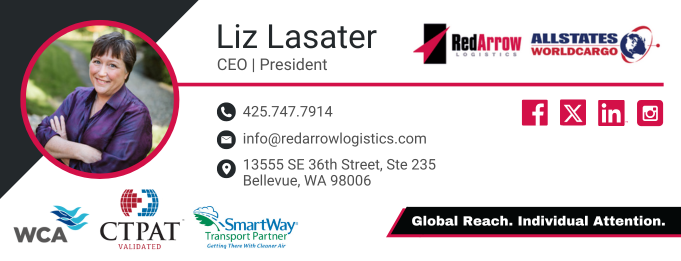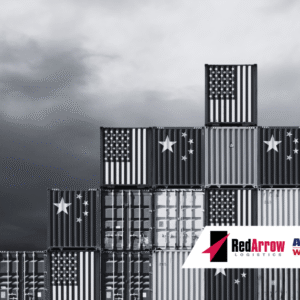The global logistics market in July 2025 reflects cautious optimism amid volatility. Ocean freight faces oversupply and tariff-driven disruptions, while airfreight benefits from e-commerce demand but navigates regulatory shifts. Ground transportation contends with capacity constraints, and e-commerce continues to drive freight volumes. U.S. tariff policies are reshaping trade flows, requiring strategic adjustments. Supply chain resilience and sustainability remain critical for success in this dynamic environment.
Ocean Freight: Ocean freight in July 2025 is shaped by a global capacity increase of 6%, outpacing demand growth at 3%, potentially driving rates down 15-17% year-over-year. Red Sea disruptions continue, forcing rerouting around the Cape of Good Hope, adding two weeks to lead times and encouraging earlier shipments. U.S. tariffs are prompting frontloading, contributing to rate volatility, though rates remain 140% above 2019 levels. Headhaul trades are expected to stabilize by mid-2025. Shippers should secure long-term contracts to hedge against fluctuations.
Airfreight: Airfreight demand in July 2025 remains strong, driven by e-commerce and time-sensitive goods like electronics and pharmaceuticals. Global air cargo rates are up 4% year-over-year in Q1, with stable capacity on U.S. and Europe routes but tighter Intra-Asia lanes, especially to India. The U.S. de minimis rule change, potentially ending duty-free imports under $800, is shifting some volumes to ocean freight, though airfreight retains its edge for speed. Middle East conflicts disrupted 1,800 Europe-bound flights in June, impacting operations. SAF-enabled services are growing, and shippers should leverage free trade zones to manage costs.
Ground Transportation: Ground transportation in July 2025 faces capacity constraints, with a U.S. truck driver shortage of 80,000 and rising port tariffs increasing costs. Pre-pandemic demand levels for trucking and rail, combined with rerouted ocean freight, are driving freight rates higher. Digital tools, adopted by 70% of carriers, like GPS tracking and electronic logging devices, improve efficiency. Sustainability efforts are accelerating, with 45% of logistics firms using electric or alternative fuel vehicles. Nearshoring to Mexico creates trade imbalances, with 4-6 northbound shipments per southbound trip, requiring optimized repositioning.
E-commerce: E-commerce remains a key driver in July 2025, with global parcel shipping volumes up 35% from 2021-2023 and freight volumes rising 4% due to a 1% increase in consumer spending share (19% to 20%). It fuels airfreight for high-value goods and demands faster last-mile ground solutions. Omnichannel logistics and micro-fulfillment centers near urban areas are critical for same-day delivery. Regulatory changes, like U.S. de minimis shifts, may raise costs, pushing shippers toward multimodal strategies and predictive analytics for demand planning.
U.S. Tariffs: U.S. tariff policies in July 2025 are significantly impacting global logistics. Proposed tariffs include a 20% increase on international goods and up to 100% on Chinese exports, driving frontloading of shipments and contributing to ocean and airfreight rate volatility. These tariffs, combined with the potential end of the de minimis rule for duty-free imports under $800, are shifting e-commerce volumes toward costlier supply chains, particularly affecting Asia-Pacific trade lanes. Importers are diversifying sourcing to countries like Vietnam and Mexico, increasing demand for cross-border ground transport. Agents should monitor tariff developments and explore alternative sourcing strategies to mitigate cost increases.
The USTR 301 tariffs will impact the ocean freight industry by introducing charges to steamship lines based on each port of call. These costs will likely be passed on to importers and ultimately, consumers. As steamship lines seek to minimize these fees, they may limit the number of ports of call, potentially creating more congestion in gateway ports. This shift could lead to increased dwell times, higher costs, and logistical challenges for shippers and importers. We’ll continue to monitor the situation and provide updates on how these changes may affect your shipments.
Your Trusted Partner
At Red Arrow Logistics, we provide expertise and white glove customer service with fast-growing, complex, and high-value supply chains. As the next-generation model of logistics companies, we offer tailored transportation and logistics solutions to meet your international shipping needs. We are an NVOCC, OTI license holder, and an IATA freight forwarder. We have partnerships in over 185+ countries to handle all of your required needs.
In partnership with Allstates WorldCargo, our parent company, Red Arrow Logistics offers the scale and scope to handle your air, ocean, imports, and exports. No shipment is too large or too small. If we can be of assistance, please email us at international@redarrowlogistics.com or give us a call at 425-747-7914.





